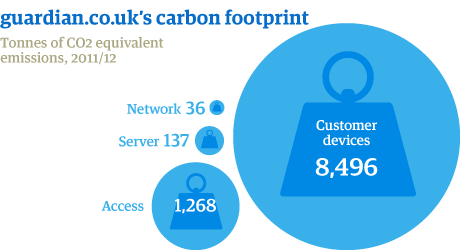Dop by the Guardian newspaper’s realistic computation of the carbon footprint of their web operations:
Digital carbon footprint: steps in the right direction
http://www.guardian.co.uk/sustainability/sustainability-report-2012-digital-carbon-footprint
The Guardian used the services of Sympact Project, at the University of Bristol and Surrey.
This group is doing research similar to that done by Alma Media on carbon footprints of online versus print media — though unfortunately, the original link to the Alma Media study is no longer valid. The take-home for Sympact and Alma Media alike is that, far from being weightless, web services consume lots of energy. In the case of The Guardian, it is about 1/3 of their overall business carbon footprint.
The Sympact study also shows that the consumer end is where most of the “dirty bits” are. Here is a link to one of the article infographics:

This reinforces other studies (e.g. by Steve Souders) that imply that server bits are generally “greener.” For that reason, we can call into question the current practice of running JavaScript-based feature detection as our only way of “sniffing” a browser. For old browsers, with “fossil” user-agents, it should be possible to sniff on the server. The end result is that feature-detection will be a little less expensive, carbon-wise. The server can also cache its results, and use that to do (dreaded word) content adaptation. I’m incorporating this idea into my Green Boilerplate project.
The Sympact study also makes it clear that “mobile first” is a way to web sustainability. Compared to laptops, mobiles in the study are shown to use 1/4 the energy. Desktops (particularly those with no power management) will have an even higher footprint. Tablets fall midway between laptops and cellphones. It’s worth remembering that desktops with monster screens and hardware accelerator cards (like those favored by the typical web/graphic designer) will suck even more power.
But mobile first won’t work if we just switch to mobiles. Compared to the devices and the “wired” Internet, mobile networks use a lot of power. A 2009 book on the “carbon footprint of everything” entitled How Bad are Bananas, gives the following stats for mobile use:
| Mobile Activity | C02 Equivalents |
|---|---|
| Manufacture | 16kg |
| 1 minute mobile use | 57g |
| 3 minutes mobile use | mailing a 2nd class letter |
| 1 year at 2 minutes per day | 47kg |
| 1 year at 1 hour per day | 1250kg CO2e |
These calculations are surprisingly high, and this is because the author of the book, Mike Berners-Lee, included estimates for the costs of building and maintaining the mobile towers, administration, transport and sales. These stats show that mobile networks are very energy-intensive, even if the devices they support are low-power. After all, driving a mid-sized car for one year converts gasoline into about 8000kg of CO2. In other words, using your cellphone is equivalent to driving your car for a couple of months.
While the Alma Media newspaper/online study was a one-off, Sympact is taking a more comprehensive approach to energy costs and sustainability of virtual versus physical media. A sample post shows how Sympact is really thinking about the virtual world.
http://sympact.cs.bris.ac.uk/2011/09/29/how-serious-is-digital-waste/
Just as we produce physical waste – unwanted and no-longer used material- there is plenty of waste in the digital world. A large website may be downloaded, and only part of it read. A podcast may be subscribed to, but forgotten and not accessed. A video may be downloaded, skimmed rapidly through and found to be useless, attachments may be shared and not viewed, and of course an email may be filling our inbox with useless information. Clearly all these use resources – energy and money – to download, transfer and process them; resources which go to waste. But how significant is this?
Another quote on the costs of upgrading devices:
http://sympact.cs.bris.ac.uk/2011/09/29/on-the-environmental-costs-of-device-upgrade/
If we take a hypothetical device with a 50% use footprint, and replace it after two years rather than three, then it will increase our overall footprint by 25%.
This link has information about their models (some nice diagrams)
http://www.systemdynamics.org/conferences/2011/proceed/papers/P1040.pdf
One disappointment is the age of the posts – the Guardian article is new, but the Sympat blog doesn’t have any posts more recent than early 2012. One hopes this is a temporary state – it is good to see academic work on the concept of Sustainable Virtual Design!
Scatalogical Equivalence
While it’s useful to compare print versus media, other comparisons are more telling. Animal memory requires an emotional “jolt” to make the memory permanent, which is why we remember moments when we were especially happy or scared, and why we don’t remember dry analytical facts. So, in the spirit of WWWaste.fr, here is a site that equates the CO2 released in one tweet to the CO2 released by one fart. Unlike the statistics above, it is something you’ll be able to quote to your friends at your next party…
Tweetfarts
http://tweetfarts.com/


1 Comment